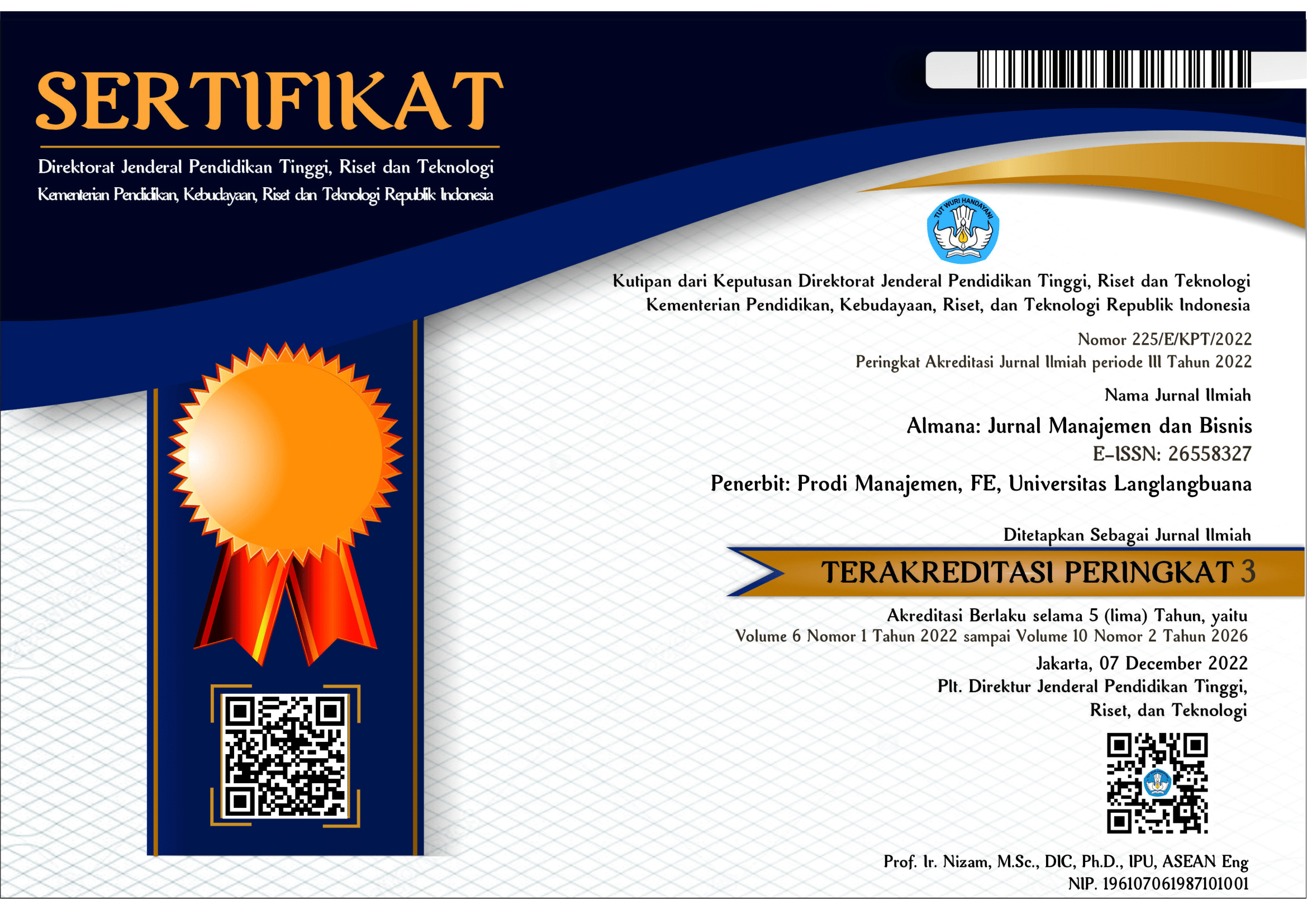Communication Strategy in Improving Satisfaction E-Commerce Customers
DOI:
https://doi.org/10.36555/almana.v5i2.1493Keywords:
Business Communication Strategy, Customer Satisfaction, Product SaleAbstract
At this time, product marketing competition is experiencing dynamic changes and is getting higher. Therefore, companies are required to choose the right marketing strategy to support increased product sales. Business communication is one of the strategies that companies can apply. This is because business communication is an attempt to provide information to customers. Accuracy in implementing business communication will cause positive customer reactions to the products being sold. This study aims to determine how the implementation of business communication strategies by e-commerce companies in Indonesia creates customer satisfaction with the services. This study uses a qualitative and quantitative method approach—research data, using primary and secondary data. Primary data were obtained directly from research respondents through interviews and questionnaires. On the other hand, secondary data is obtained based on existing library sources. Data collection, obtained from 30 customers who use e-commerce purchases. Data analysis was performed using descriptive techniques and a simple linear regression test. The results showed that the involvement of managers and field staff in providing services to customers increased sales. This finding shows that the right business communication strategy has a positive impact on customer trust reactions, which in turn increases product sales.
References
(APJII), A. P. J. I. I. (2013). Survei Penggunaan Internet Sektor Bisnis 2013. https://apjii.or.id/content/read/39/28/Survei-Penggunaan-Internet-Sektor-Bisnis-2013
Arwiedya, M. R., & Sugiarto, S. (2011). Analisis Pengaruh Harga, Jenis Media Promosi, Resiko Kinerja, dan Keragaman Produk Terhadap Keputusan Pembelian Via Internet Pada Toko Online (Studi Kasus Pada Konsumen Toko Fashion Online yang bertindak sebagai Reseller yang ada di Indonesia). Universitas Diponegoro.
BPS (Badan Pusat Statistik). (2019). Statistik Telekomunikasi Indonesia 2019. https://www.bps.go.id/publication/2020/12/02/be999725b7aeee62d84c6660/statistik-telekomunikasi-indonesia-2019.html
Broadbent, D. E. (2013). Perception and communication. Elsevier.
Broadbent, S. (2020). Approaches to personal communication. In Digital anthropology (pp. 127–145). Routledge.
Castells, M. (2013). Communication power. OUP Oxford.
Chaturvedi, P. D. (2011). Business communication: Concepts, cases, and applications. Pearson Education India.
Erlangga, H., & Sos, S. (2020). The Challenges of Organizational Communication in the Digital Era.
Fatimah, S. (2017). Strategi Komunikasi Pemasaran E-Commerce Melalui Website Klikhotel. com. Jurnal Common, 1(2).
Ferinia, R., Kurniullah, A. Z., Naipospos, N. Y., Tjiptadi, D. D., Gandasari, D., Metanfanuan, T., Karundeng, M. L., &
Purba, B. (2020). Komunikasi Bisnis. Yayasan Kita Menulis.
Kotler, P., & Keller, K. L. (2016). A framework for marketing management. Pearson Boston, MA.
Kotler, P., Makens, J. C., Bowen, J. T., & Baloglu, S. (2018). Marketing for hospitality and tourism. Pearson Education.
Kurniawan, M. I. (2019). Strategi Komunikasi Pemasaran Dazzle and Angel dalam Meningkatkan Penjualan Periode 2017. Universitas Mercu Buana Jakarta.
Kusuma, A. (2020). Komunikasi Personal Terhadap Nilai Transaksi dan Kepuasan Konsumen. Inovator, 9(1), 1–7.
Laudon, K. C., & Traver, C. G. (2013). E-commerce. Pearson Boston, MA.
Lee, E. A., & Messerschmitt, D. G. (2012). Digital communication. Springer Science & Business Media.
Liliweri, A. (2017). Komunikasi antar personal. Prenada Media.
Matviiets, O., & Kipen, V. (2021). The features of direct marketing and personal selling as a form of marketing communications. VUZF Review, 6(2), 139–145.
McQuail, D. (2011). Teori komunikasi massa. Salemba Humanika.
Mihart, C. (2012). Impact of integrated marketing communication on consumer behaviour: Effects on consumer decision-making process. International Journal of Marketing Studies, 4(2), 121.
Muscalu, E., Todericiu, R., & Fraticiu, L. (2013). Efficient organizational communication–A key to success. Studies in Business and Economics, 8(2), 74–78.
Nurhadi, Z. F., & Kurniawan, A. W. (2018). Kajian Tentang Efektivitas Pesan dalam Komunikasi. Jurnal Komunikasi Universitas Garut: Hasil Pemikiran Dan Penelitian, 3(1), 90–95.
Oktarina, Y., & Abdullah, Y. (2017). Komunikasi dalam perspektif teori dan praktik. Deepublish.
Purwanto, D. (2011). Komunikasi bisnis edisi 3.
Rafaeli, A., Altman, D., Gremler, D. D., Huang, M.-H., Grewal, D., Iyer, B., Parasuraman, A., & de Ruyter, K. (2017). The future of frontline research: Invited commentaries. Journal of Service Research, 20(1), 91–99.
Rahmidani, R. (2015). Penggunaan e-commerce dalam bisnis sebagai sumber keunggulan bersaing perusahaan. Pengguna. E-Commerce Dalam Bisnis Sebagai Sumber Keunggulan Bersaing Perusah., No. C, 345–352.
Romli, K. (2017). Komunikasi massa. Gramedia Widiasarana Indonesia.
Sari, A. A. (2017). Komunikasi antarpribadi. Deepublish.
Siddiqi, K. O. (2011). Interrelations between service quality attributes, customer satisfaction and customer loyalty in the retail banking sector in Bangladesh. International Journal of Business and Management, 6(3), 12.
Sufa, F., & Dwiyanto, B. M. (2012). Analisis Pengaruh Daya Tarik Iklan, Kualitas Pesan Iklan, dan Frekuensi Penayangan Iklan Terhadap Efektivitas Iklan Televisi Mie Sedap (Survei Pemirsa Iklan Mie Sedap Pada Mahasiswa Kost di sekitar Undip Tembalang, Semarang). Fakultas Ekonomika dan Bisnis.
Turban, E., Volonino, L., Sipior, J. C., & Wood, G. R. (2011). Information technology for management: Improving strategic and operational performance. John Wiley New York.
Van Wijmen, M. P. S., Pasman, H. R. W., Widdershoven, G. A. M., & Onwuteaka-Philipsen, B. D. (2014). Motivations, aims and communication around advance directives: a mixed-methods study into the perspective of their owners and the influence of a current illness. Patient Education and Counseling, 95(3), 393–399.
Velentzas, J., & Broni, G. (2014). Communication cycle: Definition, process, models and examples. Recent Advances in Financial Planning and Product Development, 117–131.
Zeithaml, V. A., Verleye, K., Hatak, I., Koller, M., & Zauner, A. (2020). Three decades of customer value research: paradigmatic roots and future research avenues. Journal of Service Research, 23(4), 409–432.







